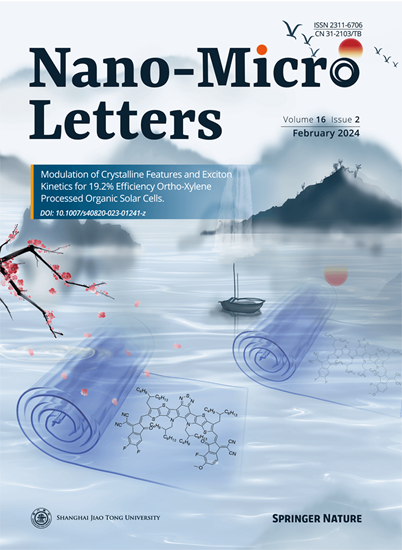Boron-Insertion-Induced Lattice Engineering of Rh Nanocrystals Toward Enhanced Electrocatalytic Conversion of Nitric Oxide to Ammonia
IF 36.3
1区 材料科学
Q1 Engineering
引用次数: 0
Abstract
Highlights
-
Phase regulation of B-inserted rhodium (Rh) nanocrystals is achieved using a facile wet-chemical approach.
-
The B-inserted Rh nanocatalysts exhibit phase-dependent behaviors in electrocatalytic nitric oxide (NO) reduction reaction.
-
The hexagonal close-packed RhB nanocatalysts demonstrate superior electrocatalytic activity in NH3 production with a maximum NH3 yield rate of 629.5 µmol h−1 cm−2 and FENH3 of 92.1%.
-
Theoretical simulations reveal possible origin of the excellent electrocatalytic activity, which could be attributed to the d-band center upshift, enhanced NO adsorption/activation, and reduced energy barrier of rate-determining step.
硼插入诱导的Rh纳米晶体晶格工程用于增强一氧化氮转化为氨的电催化。
电催化氧化氮(NO)还原反应(NORR)可以同时实现绿色氨(NH3)的合成和有害NO的去除,是一种有前途的可持续发展的工艺。然而,由于缺乏高效的电催化剂,目前的NORR性能与实际需要相差甚远。通过相控制来设计金属基纳米材料的晶格已经成为一种有效的策略来调节其固有的电催化性能。本研究通过简单的湿化学方法,实现了硼(B)插入诱导的铑(Rh)纳米晶体的相调节,获得了非晶Rh4B纳米粒子(NPs)和六方密排RhB纳米粒子(hcp)。hcp RhB NPs具有较高的法拉第效率(92.1±1.2%)和NH3产率(629.5±11.0µmol h-1 cm-2),远远优于大多数报道的NORR纳米催化剂。原位光谱电化学分析和密度泛函理论模拟表明,hcp RhB NPs优异的电催化性能主要归因于d波段中心的上移、NO吸附/活化谱的增强和速率决定步骤的能量势垒的大幅降低。以hcp RhB NPs为阴极组装了示范性Zn-NO电池,其峰值功率密度为4.33 mW cm-2,同时实现了NO去除、NH3合成和电力输出。
本文章由计算机程序翻译,如有差异,请以英文原文为准。
求助全文
约1分钟内获得全文
求助全文
来源期刊

Nano-Micro Letters
NANOSCIENCE & NANOTECHNOLOGY-MATERIALS SCIENCE, MULTIDISCIPLINARY
CiteScore
32.60
自引率
4.90%
发文量
981
审稿时长
1.1 months
期刊介绍:
Nano-Micro Letters is a peer-reviewed, international, interdisciplinary, and open-access journal published under the SpringerOpen brand.
Nano-Micro Letters focuses on the science, experiments, engineering, technologies, and applications of nano- or microscale structures and systems in various fields such as physics, chemistry, biology, material science, and pharmacy.It also explores the expanding interfaces between these fields.
Nano-Micro Letters particularly emphasizes the bottom-up approach in the length scale from nano to micro. This approach is crucial for achieving industrial applications in nanotechnology, as it involves the assembly, modification, and control of nanostructures on a microscale.
 求助内容:
求助内容: 应助结果提醒方式:
应助结果提醒方式:


